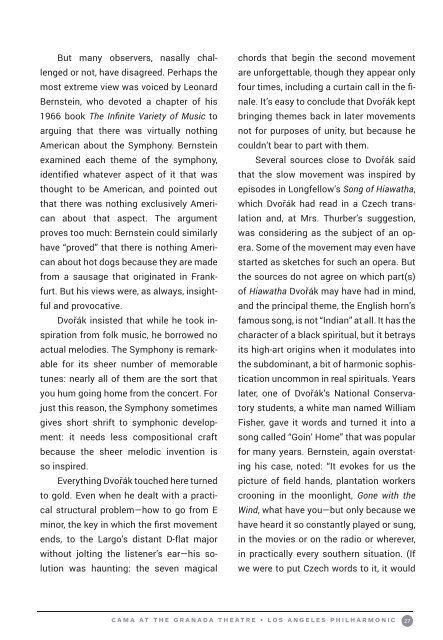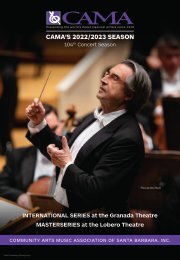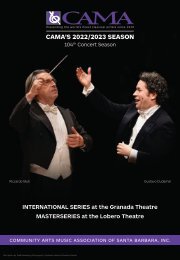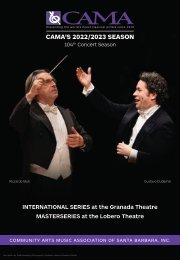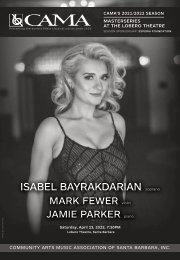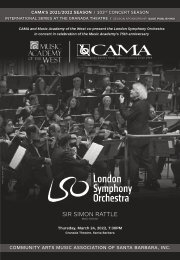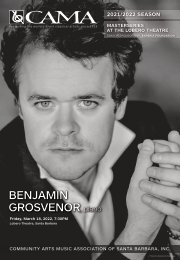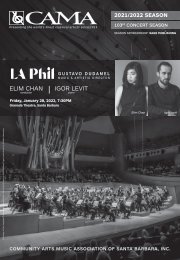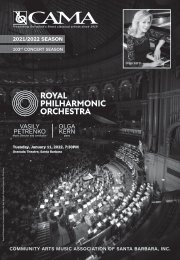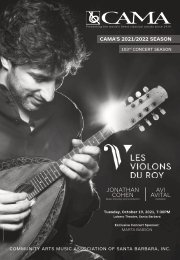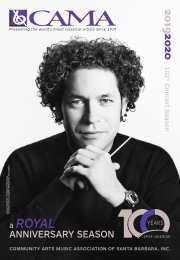CAMA + LA Phil / Gala 100th Anniversary Concert / 100 Years to the Day / March 6, 1920 – March 6, 2020 / International Series at The Granada Theatre
On Friday, March 6, 2020, LA Phil will play a special 100th Anniversary Concert at The Granada Theatre in Santa Barbara as part of CAMA's 101st Season. Maestro Gustavo Dudamel will direct a program of Charles Ives and Antonin Dvorak's New World Symphony. This concert marks 100 years to the day from LA Phil's first concert in Santa Barbara on March 6, 1920. CAMA and LA Phil join in celebrating this remarkable "Centennial moment!" — Photo of Gustavo Dudamel ©Citizens of Humanity, courtesy of the Los Angeles Philharmonic Association. ★—CONCERT AND SPECIAL EVENTS: Friday, March 6, 2020—★ 5:00PM doors/5:15PM start—LECTURE by Hattie Beresford at The New Vic Theater—Open to All Reservations recommended—email tickets@camasb.org 6:00PM—RED-CARPET RECEPTION at The Granada Theatre All ticket holders invited—no reservation needed 7:00PM—CONCERT (The Granada Theatre) / No Late Seating / Concert ends approx.9:00PM More information: https://camasb.org/international-series-2019-2020/#2020-03-06 #CAMASB #CAMA101 #CAMACentennial #LAPhil100 #CAMAat100
On Friday, March 6, 2020, LA Phil will play a special 100th Anniversary Concert at The Granada Theatre in Santa Barbara as part of CAMA's 101st Season. Maestro Gustavo Dudamel will direct a program of Charles Ives and Antonin Dvorak's New World Symphony. This concert marks 100 years to the day from LA Phil's first concert in Santa Barbara on March 6, 1920. CAMA and LA Phil join in celebrating this remarkable "Centennial moment!" — Photo of Gustavo Dudamel ©Citizens of Humanity, courtesy of the Los Angeles Philharmonic Association.
★—CONCERT AND SPECIAL EVENTS: Friday, March 6, 2020—★
5:00PM doors/5:15PM start—LECTURE by Hattie Beresford at The New Vic Theater—Open to All
Reservations recommended—email tickets@camasb.org
6:00PM—RED-CARPET RECEPTION at The Granada Theatre
All ticket holders invited—no reservation needed
7:00PM—CONCERT (The Granada Theatre) / No Late Seating / Concert ends approx.9:00PM
More information: https://camasb.org/international-series-2019-2020/#2020-03-06
#CAMASB #CAMA101 #CAMACentennial #LAPhil100 #CAMAat100
You also want an ePaper? Increase the reach of your titles
YUMPU automatically turns print PDFs into web optimized ePapers that Google loves.
But many observers, nasally challenged<br />
or not, have disagreed. Perhaps <strong>the</strong><br />
most extreme view was voiced by Leonard<br />
Bernstein, who devoted a chapter of his<br />
1966 book <strong>The</strong> Infinite Variety of Music <strong>to</strong><br />
arguing th<strong>at</strong> <strong>the</strong>re was virtually nothing<br />
American about <strong>the</strong> Symphony. Bernstein<br />
examined each <strong>the</strong>me of <strong>the</strong> symphony,<br />
identified wh<strong>at</strong>ever aspect of it th<strong>at</strong> was<br />
thought <strong>to</strong> be American, and pointed out<br />
th<strong>at</strong> <strong>the</strong>re was nothing exclusively American<br />
about th<strong>at</strong> aspect. <strong>The</strong> argument<br />
proves <strong>to</strong>o much: Bernstein could similarly<br />
have “proved” th<strong>at</strong> <strong>the</strong>re is nothing American<br />
about hot dogs because <strong>the</strong>y are made<br />
from a sausage th<strong>at</strong> origin<strong>at</strong>ed in Frankfurt.<br />
But his views were, as always, insightful<br />
and provoc<strong>at</strong>ive.<br />
Dvořák insisted th<strong>at</strong> while he <strong>to</strong>ok inspir<strong>at</strong>ion<br />
from folk music, he borrowed no<br />
actual melodies. <strong>The</strong> Symphony is remarkable<br />
for its sheer number of memorable<br />
tunes: nearly all of <strong>the</strong>m are <strong>the</strong> sort th<strong>at</strong><br />
you hum going home from <strong>the</strong> concert. For<br />
just this reason, <strong>the</strong> Symphony sometimes<br />
gives short shrift <strong>to</strong> symphonic development:<br />
it needs less compositional craft<br />
because <strong>the</strong> sheer melodic invention is<br />
so inspired.<br />
Everything Dvořák <strong>to</strong>uched here turned<br />
<strong>to</strong> gold. Even when he dealt with a practical<br />
structural problem—how <strong>to</strong> go from E<br />
minor, <strong>the</strong> key in which <strong>the</strong> first movement<br />
ends, <strong>to</strong> <strong>the</strong> Largo’s distant D-fl<strong>at</strong> major<br />
without jolting <strong>the</strong> listener’s ear—his solution<br />
was haunting: <strong>the</strong> seven magical<br />
chords th<strong>at</strong> begin <strong>the</strong> second movement<br />
are unforgettable, though <strong>the</strong>y appear only<br />
four times, including a curtain call in <strong>the</strong> finale.<br />
It’s easy <strong>to</strong> conclude th<strong>at</strong> Dvořák kept<br />
bringing <strong>the</strong>mes back in l<strong>at</strong>er movements<br />
not for purposes of unity, but because he<br />
couldn’t bear <strong>to</strong> part with <strong>the</strong>m.<br />
Several sources close <strong>to</strong> Dvořák said<br />
th<strong>at</strong> <strong>the</strong> slow movement was inspired by<br />
episodes in Longfellow’s Song of Hiaw<strong>at</strong>ha,<br />
which Dvořák had read in a Czech transl<strong>at</strong>ion<br />
and, <strong>at</strong> Mrs. Thurber’s suggestion,<br />
was considering as <strong>the</strong> subject of an opera.<br />
Some of <strong>the</strong> movement may even have<br />
started as sketches for such an opera. But<br />
<strong>the</strong> sources do not agree on which part(s)<br />
of Hiaw<strong>at</strong>ha Dvořák may have had in mind,<br />
and <strong>the</strong> principal <strong>the</strong>me, <strong>the</strong> English horn’s<br />
famous song, is not “Indian” <strong>at</strong> all. It has <strong>the</strong><br />
character of a black spiritual, but it betrays<br />
its high-art origins when it modul<strong>at</strong>es in<strong>to</strong><br />
<strong>the</strong> subdominant, a bit of harmonic sophistic<strong>at</strong>ion<br />
uncommon in real spirituals. <strong>Years</strong><br />
l<strong>at</strong>er, one of Dvořák’s N<strong>at</strong>ional Conserva<strong>to</strong>ry<br />
students, a white man named William<br />
Fisher, gave it words and turned it in<strong>to</strong> a<br />
song called “Goin’ Home” th<strong>at</strong> was popular<br />
for many years. Bernstein, again overst<strong>at</strong>ing<br />
his case, noted: “It evokes for us <strong>the</strong><br />
picture of field hands, plant<strong>at</strong>ion workers<br />
crooning in <strong>the</strong> moonlight, Gone with <strong>the</strong><br />
Wind, wh<strong>at</strong> have you—but only because we<br />
have heard it so constantly played or sung,<br />
in <strong>the</strong> movies or on <strong>the</strong> radio or wherever,<br />
in practically every sou<strong>the</strong>rn situ<strong>at</strong>ion. (If<br />
we were <strong>to</strong> put Czech words <strong>to</strong> it, it would<br />
<strong>CAMA</strong> AT THE GRANADA THEATRE • LOS ANGELES PHILHARMONIC<br />
27


